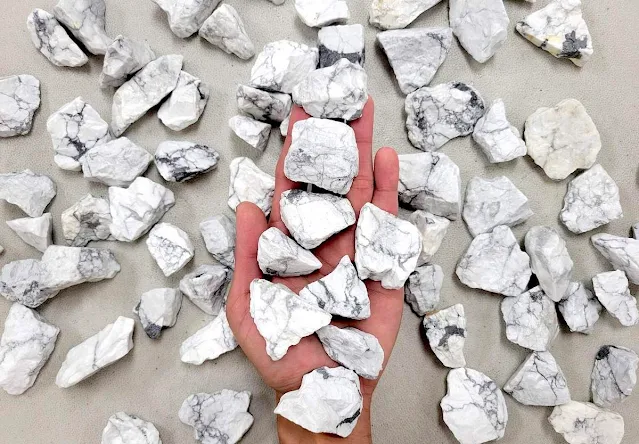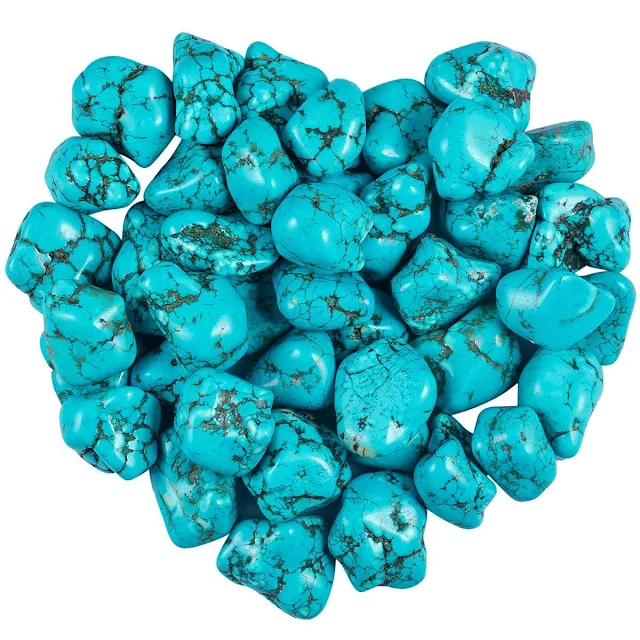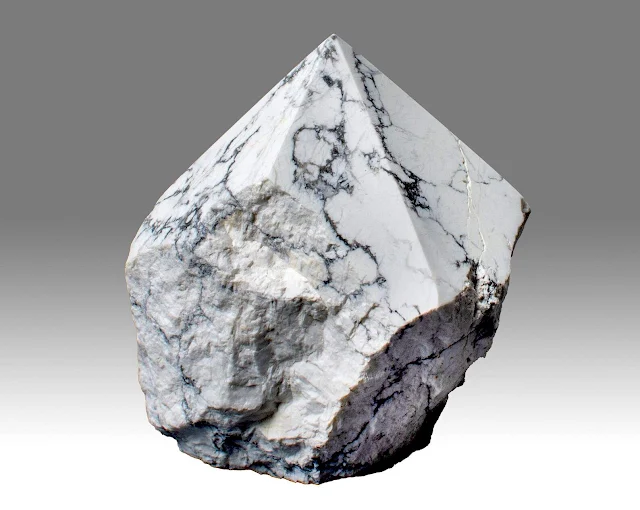Howlite: Meaning, Properties, Uses
Howlite is a borate mineral that belongs to the group of boron-bearing minerals. It is composed of calcium borosilicate hydroxide and is often found in sedimentary rock formations. Howlite is known for its distinctive appearance, typically occurring in masses with a white to light gray color and gray to black veining. The veining patterns can give Howlite a marbled or spiderweb-like look.
The largest deposits of Howlite are found in Canada, particularly in the Windsor region of Nova Scotia, where it was first discovered in 1868. Other significant deposits occur in California, especially in the Death Valley area, and Mexico.
Howlite was discovered in Nova Scotia, Canada, in the 19th century and was named after the Canadian mineralogist Henry How.
Properties of Howlite
Composition: Howlite is composed of calcium borosilicate hydroxide (Ca₂B₅SiO₉(OH)₅), belonging to the borate mineral group.
Color: Howlite typically appears white or light gray, often with gray to black veining.
Luster: Subvitreous, meaning it has a glassy sheen but not as bright as glass.
Crystal System: Howlite crystallizes in the monoclinic crystal system.
Streak: The streak of Howlite is white.
Hardness: Howlite has a relatively low hardness of 3.5 on the Mohs scale.
Cleavage: Howlite exhibits perfect cleavage in one direction, forming tabular or prismatic crystals.
Crystal Form: Howlite commonly occurs in masses rather than distinct crystals.
Density: The density of Howlite is around 2.58 to 2.69 g/cm³.
Transparency: Howlite is typically opaque.
Fracture: Howlite exhibits an uneven to subconchoidal fracture.
Specific Gravity: The specific gravity of Howlite is approximately 2.58 to 2.59.
Solubility: Howlite is insoluble in water.
Magnetism: Howlite is not magnetic.
Fluorescence: Howlite may exhibit fluorescence under ultraviolet (UV) light.
Pleochroism: Howlite typically does not show pleochroism, meaning it does not display different colors when viewed from different angles.
Refractive Index: The refractive index of Howlite ranges from approximately 1.58 to 1.61.
Inclusions: Howlite may contain various inclusions, such as mineral veins or impurities, which contribute to its veining pattern.
 |
| Howlite Rough |
Formation of Howlite
Howlite forms through a combination of geological processes involving the alteration of pre-existing minerals.
Primary Formation: Howlite primarily forms in evaporite deposits, which are sedimentary rocks created by the evaporation of water rich in dissolved minerals. This often occurs in arid environments like deserts.
Alteration: Volcanic ash plays a crucial role. When volcanic ash mixes with water in these evaporite deposits, it undergoes a series of chemical reactions. These reactions involve the interaction of silica (from ash) with boron and calcium (present in the water), ultimately leading to the formation of Howlite.
Secondary Processes: Additionally, Howlite can also form through hydrothermal processes. Here, hot fluids carrying dissolved minerals penetrate existing rock formations, depositing minerals like Howlite in fractures and cavities. In some cases, metamorphic processes involving heat and pressure can also contribute to Howlite formation.
Howlite is often found in association with other minerals, including gypsum, calcite, and sometimes with turquoise. The mineral's appearance, with its white to light gray color and characteristic veins, is a result of the specific conditions under which it forms. It is worth noting that Howlite can be found in various geological settings, including sedimentary deposits and metamorphic rocks.
 |
Howlite Turquoise |
Howlite Turquoise
Howlite turquoise, also known as magnesite turquoise or turquoise magnesite, is a popular gemstone often used in jewelry and decorative objects. It's not actually turquoise, but rather a white, porous mineral called howlite that's been dyed to resemble the beautiful blue-green color of real turquoise.
How to identify howlite turquoise:
Price: Howlite turquoise is significantly cheaper than real turquoise, which can be a giveaway.
Weight: It's lighter than genuine turquoise due to its lower density.
Porosity: You may be able to see tiny holes or imperfections on the surface, indicating its porous nature.
Dye: Look for signs of dye residue, especially around drilled holes or on scratched areas.
When purchasing turquoise or turquoise-like stones, it's advisable to inquire about the treatment and ensure transparency from the seller.
Uses and Applications of Howlite
Howlite is a versatile mineral that has various uses, primarily in the fields of jewelry making, ornamental objects, and spiritual practices. Here are some common applications and uses of Howlite:
Jewelry Making: Howlite is often used in the creation of beads, cabochons, and other jewelry components. Its white to light gray color, often with black veining, provides a distinctive and attractive appearance. Howlite is also commonly dyed to resemble other gemstones, such as turquoise, making it an affordable alternative.
Ornamental Objects: Howlite is carved into decorative objects, figurines, and sculptures. Its unique veining patterns add an aesthetic appeal, and its relatively soft nature makes it suitable for carving intricate designs.
Home Decor: Polished Howlite pieces, whether in the form of spheres, eggs, or other shapes, are sometimes used as decorative items in homes. These items can add a touch of natural beauty to interior spaces.
Lapidary Arts: Howlite's relative softness makes it suitable for lapidary arts, where it can be shaped, polished, and used in various artistic creations.
Education and Research: Howlite is sometimes used in educational settings and research laboratories for its distinctive characteristics. Its study can contribute to a better understanding of mineralogy and geological processes.
Fashion Accessories: Apart from traditional jewelry, Howlite may also be incorporated into fashion accessories, such as earrings, bracelets, and pendants.
Dyed Howlite: Due to its porous nature, Howlite can easily absorb dyes. This allows it to be transformed into a variety of vibrant colors, expanding its range of aesthetic possibilities in jewelry and artistic designs.
While Howlite is not as well-known as some other gemstones, its affordability and unique appearance make it a popular choice for those looking for an attractive and distinctive mineral in various creative and spiritual applications.
 |
| Polished howlite |
Howlite Meaning
Howlite is believed to possess various meanings and properties, often associated with its appearance, energetic qualities, and historical context. Some common interpretations of the meaning of Howlite include:
Calming and Soothing: Howlite is often regarded as a stone of calmness and tranquility. It is believed to have a calming effect on the mind, body, and emotions, helping to reduce stress, anxiety, and tension.
Awareness and Insight: Howlite is associated with enhancing awareness and insight. It is said to promote mindfulness, clarity of thought, and a deeper understanding of oneself and one's surroundings.
Patience and Emotional Balance: Howlite is thought to encourage patience, emotional balance, and inner peace. It may assist in tempering anger, frustration, and impatience, fostering a more serene and harmonious state of being.
Communication and Expression: Some believe that Howlite supports effective communication and self-expression. It is said to facilitate clear and honest communication, both with oneself and with others, aiding in the expression of thoughts, feelings, and ideas.
Spiritual Growth: Howlite is associated with spiritual growth and enlightenment. It is believed to stimulate spiritual awareness, intuition, and connection to higher consciousness, leading to personal growth and self-realization.
Healing and Rejuvenation: Howlite is sometimes used for its healing properties, particularly in holistic and alternative medicine. It is believed to promote physical healing, relieve physical discomfort, and support overall well-being.
Dream Recall and Insight: Some practitioners believe that Howlite can enhance dream recall and facilitate insightful dream experiences. It is said to deepen the connection to the subconscious mind and uncover hidden truths and insights.
Is Howlite Toxic
Howlite is not considered toxic in its natural state. It's composed of calcium borosilicate hydroxide, which is not harmful when handled normally. While there are some concerns surrounding Howlite's potential toxicity, it's generally considered safe for normal wear and handling.
Howlite Vs. Magnesite
Magnesite and Howlite are two distinct minerals, but they share some similarities in terms of appearance and usage.
Magnesite and Howlite are both minerals prized for their diverse applications and distinctive properties. Magnesite, a magnesium carbonate mineral, typically presents in shades of white, gray, or brown and is utilized in industrial applications such as refractory materials and magnesium production. Its vitreous to pearly luster and trigonal crystal system distinguish it. Howlite, a calcium borosilicate hydroxide, is known for its white to light gray color with gray to black veining and matte luster. It is often used in jewelry making, meditation practices, and ornamental objects due to its calming energies. Howlite has a monoclinic crystal system and is valued for its spiritual significance, promoting awareness, patience, and emotional balance. While both minerals have unique characteristics and uses, their individual compositions and properties cater to diverse industries and personal preferences.
Conclusion
Howlite, with its tranquil hues and intricate veins, continues to captivate admirers in both the realms of aesthetics and holistic practices. Whether adorning jewelry or finding a place in meditative spaces, Howlite's understated beauty and calming energies make it a gemstone that resonates on both a visual and spiritual level.









